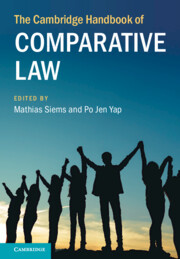Book contents
- The Cambridge Handbook of Comparative Law
- The Cambridge Handbook of Comparative Law
- Copyright page
- Contents
- Figures
- Tables
- Contributors
- Preface
- Abbreviations
- 1 Introduction
- Part I Methods of Comparative Law
- Part II Legal Families and Geographical Comparisons
- 11 Civil Law
- 12 Common Law
- 13 Confucian Legal Tradition
- 14 Former Soviet States of Eastern Europe, Caucasus and Central Asia
- 15 Latin America
- 16 Middle East and North Africa
- 17 South Asia
- 18 Sub-Saharan Africa
- Part III Central Themes in Comparative Law
- Part IV Comparative Law beyond the State
- Index
12 - Common Law
from Part II - Legal Families and Geographical Comparisons
Published online by Cambridge University Press: 26 January 2024
- The Cambridge Handbook of Comparative Law
- The Cambridge Handbook of Comparative Law
- Copyright page
- Contents
- Figures
- Tables
- Contributors
- Preface
- Abbreviations
- 1 Introduction
- Part I Methods of Comparative Law
- Part II Legal Families and Geographical Comparisons
- 11 Civil Law
- 12 Common Law
- 13 Confucian Legal Tradition
- 14 Former Soviet States of Eastern Europe, Caucasus and Central Asia
- 15 Latin America
- 16 Middle East and North Africa
- 17 South Asia
- 18 Sub-Saharan Africa
- Part III Central Themes in Comparative Law
- Part IV Comparative Law beyond the State
- Index
Summary
This chapter outlines the workings of the common law. It starts out by providing a historical background to legal institutions, conceptual distinctions, pedagogy and literature constituting the common law tradition before going on to identify and discuss some of the core features of the common law’s method. The chapter also seeks identify factors causing convergences and divergences between the working of the law in many of the jurisdictions all over the world that tend to be classified as common law systems.
- Type
- Chapter
- Information
- The Cambridge Handbook of Comparative Law , pp. 235 - 255Publisher: Cambridge University PressPrint publication year: 2024

